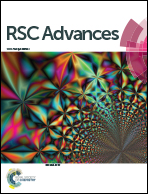O-Acrylamidomethyl-2-hydroxypropyltrimethyl ammonium chloride chitosan and silk modified mesoporous bioactive glass scaffolds with excellent mechanical properties, bioactivity and long-lasting antibacterial activity
Abstract
Mesoporous bioactive glass (MBG) is a promising scaffold in bone tissue engineering because its large specific surface area facilitates bioactive behavior and allows mesopores to be loaded with osteogenic agents for promoting the formation of new bone. In the present study, a biocompatible MBG-based scaffold for bone regeneration applications with long-lasting antibacterial activity were fabricated via surface modification with O-acrylamidomethyl-2-hydroxypropyltrimethyl ammonium chloride chitosan (NMA-HACC) and silk. The NMA-HACC–silk (NHS) modified MBG scaffolds were prepared by evaporation-induced self-assembly using polyurethane sponges and the P123 surfactant as co-templates. The microstructure of the scaffold was characterized using scanning electron microscopy (SEM) and synchrotron radiation microcomputer tomography (SRμCT). Fourier transform infrared spectroscopy (FTIR), SEM, X-ray diffraction (XRD), and mechanical experiments were used to analyze the product's composition, inner microstructure, morphology, and mechanical strength before and after its surface modification. These methods were also used to assess the degree to which minerals became deposited on the scaffold after soaking in simulated body fluid (SBF). Confocal laser scanning microscopy (CLSM) was used to evaluate the antibacterial properties and biocompatibility of the scaffolds at various time intervals. Finally, biocompatibility was demonstrated by studying the in vitro proliferation and viability of human mesenchymal stem cells (hMSCs). The results showed that the fabricated scaffolds possessed well-ordered, three-dimensional structures and the NMA-HACC–silk modification rendered the pore network more uniform and continuous, leading to the significant improvement in bioactivity and in hMSC attachment, cell spreading and cell proliferation. Furthermore, the NMA-HACC–silk modification significantly prolonged the antibacterial activity of the MBG scaffold.



 Please wait while we load your content...
Please wait while we load your content...